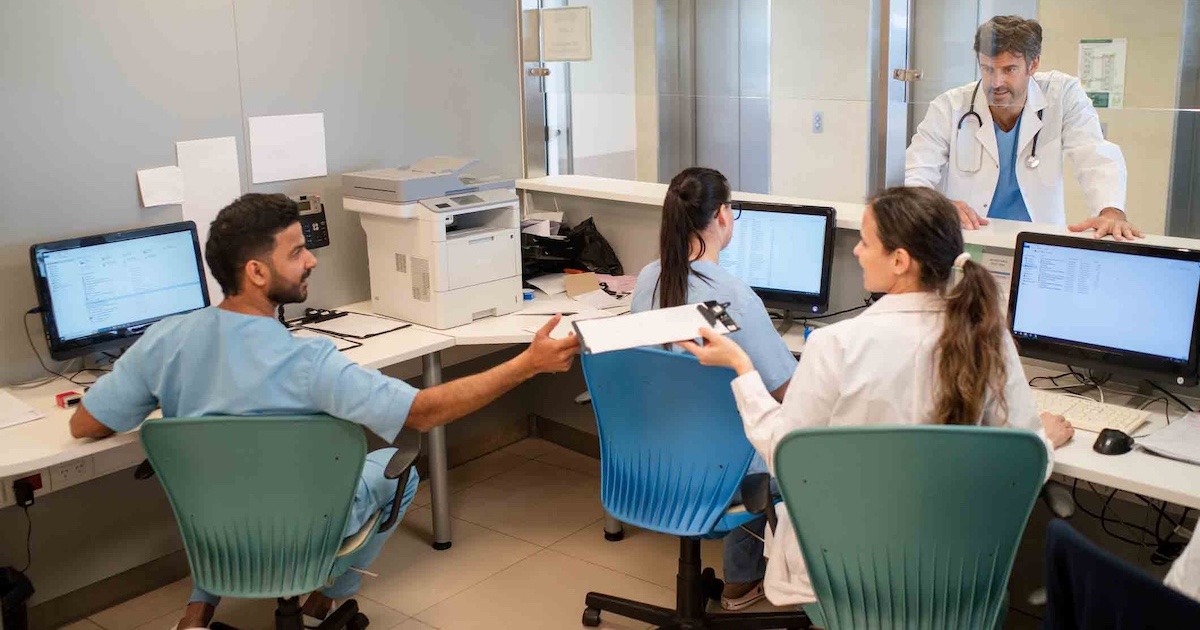Natalie Hodge, MD, is a Kentucky-based pediatrician and healthcare futurist and founder of the mHealth startup Personal Medicine Plus.
An early advisor for mHealth businesses Healthtap and Doximity, she "hopes to end lifestyle disease by implementation of a simple mobile platform that will let any global user reduce lifestyle disease simply and on their own time." She recently participated in this Q&A with mHIMSS.
1. What mobile health strategy are you planning to implement in 2014?
I am planning to prescribe a health self-management platform for patients in my practice. It is a simple UI/UX in which patients can view their entire health on one screen, including biometrics, with automated, color-coded interpretation of numbers. Patients are prescribed the app during their outpatient visits (in the same way that) I would prescribe a medicine or any other intervention.
The platform encourages simple behavior changes like drinking water (and) eating recommended fruits and vegetables, as well as a detailed exercise prescription for 10,000 steps a day. Text messages gently prod the patient to implement the healthy behaviors during the day. The app creates a "health score" that can be easily viewed by the patient, as well as their BMI (with color coding of result) in the right lower corner.
2. Even though the benefits and cost savings of mobile monitoring and telehealth have been shown in studies, why has it not been more widely adopted in the United States?
For physicians remaining in fee-for-service private practice, this is a revenue model issue. Implementation of a health remote monitoring platform will lead directly to reduced office revenues - a tenuous business model which already took a serious hit last year with FFS reimbursement reductions. mHealth will be more likely adopted by market-based practices otherwise known as concierge medicine or direct practices, because they are inherently value-based.
If a physician is part of a forward thinking Accountable Care Organization, then implementation requires alignment among the leaders in terms of strategy. It also requires acceptance within the organization's finance gatekeepers: They will want to know that shared savings will actually work, and (that) the financial reward will be there for outcomes creation. Also, alignment among specialists and generalists within the organization is a potential issue. The gap between primary care pay and specialist pay is so massively large that the specialists will resist moving forward with this kind of initiative because it decreases the income gap between the two. For example, successful implementation of in-home wellness program that successfully creates BMI reduction and smoking cessation renders entire departments like traditional radiology and traditional cardiology empty over time. There are outlier standout organizations that are ready for this.
Is your organization ready for this? Are your physicians ready to retrain on the wellness side? Or will your organization gradually retire out physician specialists and hire in new mHealth positions moving forward? This is the real potential of mHealth. An organization is massively disrupting itself. But organizations must act now because otherwise the whole organization will be disrupted by value-generating organizations as well as payers, retail stakeholders and the fast-moving health consumer internet.
The questions remaining for large organizations are which populations to implement mHealth monitoring first. There are short-term strategies (such as) readmission reduction, which is a big pain point right now. But there are forward-thinking, long-term, strategic options like implementing self-care telemedicine models across younger populations as a starting point, rather than an afterthought of an admission. Organizations are earmarking on average 25 percent of shared savings funding to implement initiatives that then further increase the wellness of the population in that following year's numbers.
We need to start thinking about using this pot of money to purchase health wellness platforms for our populations, rather than waiting for any kind of reimbursement via CPT coding model to emerge. Shared savings strategy must be implemented now. Waiting for AMA codes and payers to reimburse is a very risky strategy; organizations that wait risk failure.
3. Why is mHealth not a bigger part of Medicare/Medicaid strategy or reimbursed more widely?
The shift of the model that came with the election (of President Barack Obama) chose to use shared savings, which is overall simpler than the tedious, expensive (process of the) AMA creating codes, then lobbying for government and payers to reimburse. We have chosen as a nation through our vote an outcomes model that is simple. Reduce BMI in your population, and be rewarded. Let's not sweat the small things, like what intervention could be billed with what code. On a macro level, the former model is simplest. And it really speaks to the potential of cross-population implementation of mHealth. organizations that stand to make billions of dollars in wellness, which is where we need to be as an industry. The latter is just a complicated extension of what we already have and hate.
4. What are the important infrastructure preparations a health system must build for successful mobile monitoring?
Infrastructure prep is not the issue - what tech platforms to use is the issue. We have plenty of mobile phones/internet infrastructures and connected health devices. The issue is how do cloud platforms, mobile devices and connected health devices unite to create an easy-to-use in-home monitoring and wellness platform for individuals that starts their healthcare implementation and monitoring at home and keeps them there.
The other question is what does such a platform cost, and what is the return on investment in terms of shared savings? The potential is there for massive return on investment for health wellness programs since they are not expensive by comparison to legacy health IT. The key to understanding how to implement mHealth starts with a platform that was built by users for users and a population health back-end for results.
We will get healthcare right when we start with patients where they are and build upon that. Legacy enterprise health IT never started with users, and that is the whole problem with it. mHealth must start with end-users who are our patients, get that right, then expand to the population metrics from there to prove outcomes.
5. Do you see the increased patient engagement that accompanies mobile monitoring/telehealth playing a major role in patient-led over-use reduction? Do you think that patients by being wirelessly connected to their providers and clinicians - and with the ability to see their clinical data through mobile monitoring programs - will be more judicious in seeking emergency care or referrals?
Absolutely. A patient who has an easy-to-use in-home monitoring program with data interpretation built in to the platform as well as an engaging and gamified health tracking system will become addicted to using the app if it uses basic gaming and UI/UX principles in the same way we are addicted to finding out what our friends are doing on Facebook. Build out content and coaching that comes to the users on their terms, fitting into their workday, and you really have something. The point is to teach the user how to care for him/herself, and they will have greatly diminished the need for the hospital and physicians as a whole. The goal of mHealth is to help a user normalize their biometrics on their own in a gamified and social manner.
6. Will cost savings spur ACOs to adopt telehealth or mobile monitoring? If so, do you see private insurers following mHealth and consumer engagement guidelines?
Yes, I feel that the adoption of mHealth by large organizations will stem from the initial small proof-of-concept pilot studies that the research arms implement. If it works in 1,000 patients, then it will work in 100,000 patients (or) 1 million patients, and mHealth apps are of course easy to scale, since they are cloud-based.
To be clear about payers, they are in no way following ACOs – it is, in fact, the other way around. ACOs are actually lagging far behind payers, doing paperwork and arguing in boardrooms about who is going to get paid what, They are playing violins as the Titanic is sinking. The strategic threat is the fact that payers have already created and are implementing their own mobile wellness programs, so hospital systems and ACOs alike will become less relevant to consumers if they stay with the status quo. Payers do not require years of data and research to do something that just makes basic sense as a value-generating initiative. They are eager to pilot mHealth within various at-risk populations.
So what I am saying is that payers are already leading with engagement and mHealth programs. In fact, it's our ACOs, hospitals and professional organizations who are actually following at this point.
7. With the abilitiy to aggregate huge amounts of patient data over time through formal mobile monitoring and patient use of personal health applications, what impact do you see on medical research? How will this impact recommended care guidelines?
Medical researchers will definitely maintain high interest in health research as this market matures. Each forward-thinking ACO has a center for connected health in which to gather evidence on these emerging care models, trying it out in a smaller cohort, proving it works, before bringing it to the population at large. The major opportunity is to have a population health dashboard that shows the activity and biometrics of the population as a whole, including reductions of BMI, 30-day glucose, and blood pressure in aggregate. These three numbers will start to make older generation lab screening data less and less relevant. Reporting in the future for ACOs will stem from biometric screening data rather than labs.
Frankly, outcomes reporting from health initiatives will probably predate the actual guidance on MU4. mHealth pulls an organization out in front of MU4, which is a good place to be. Care guidelines will be turned on their ear. We will all be prescribing mHealth apps instead of metformin, lisinopril and statins.
8. Why did you download the mHIMSS Roadmap (original or v2 health apps focused version)?
I have been a longtime innovator and early adopter for things in my medical practice that just make sense. … I am a pediatrician clinical entrepreneur and have been participating in Health 2.0 since Matthew (Holt) and Indu (Subaiya) started it years ago. Health IT has largely been a separate and existing mature industry lacking in many regards for both my use as a general pediatrician and health systems at large for many reasons. So when I discovered the movement within HIMSS following mobile, and considering mobile as the ultimate tech to deliver transformative change in healthcare, I wanted to follow up and see where the organization was with regard to recommendations and implementation of mHealth as a whole. This is why I downloaded the mHIMSS Roadmap. Essentially, mHIMSS has the potential to be the absolute collision of the Health IT and Health 2.0 movements. I find myself at the epicenter of this, an outlier on the fringe of healthcare, trying to make my patients accelerate outcomes progress with a simple tool.


